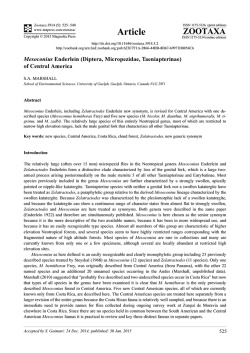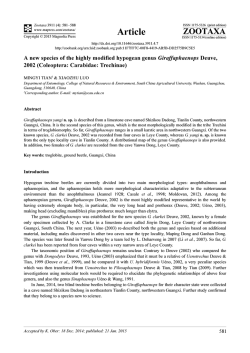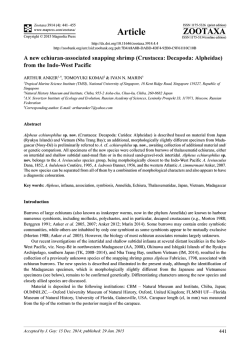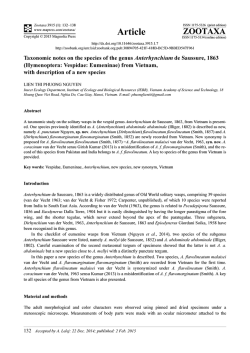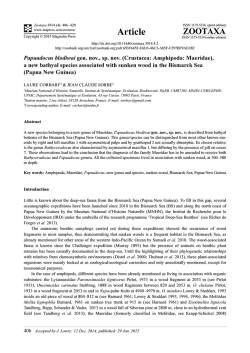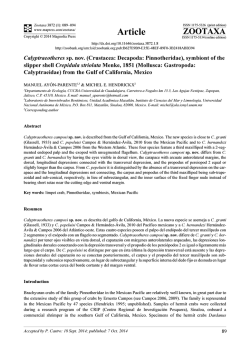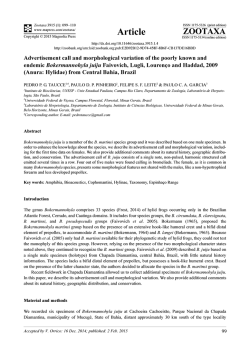
Preview - Magnolia Press
Zootaxa 3914 (4): 495–500 www.mapress.com /zootaxa / Copyright © 2015 Magnolia Press ISSN 1175-5326 (print edition) Correspondence ZOOTAXA ISSN 1175-5334 (online edition) http://dx.doi.org/10.11646/zootaxa.3914.4.9 http://zoobank.org/urn:lsid:zoobank.org:pub:8744E558-5BF8-43CB-8703-7EC047A23970 On some recent taxonomic advancement and the resultant problems in the arboreal skink genus Dasia Gray, 1839 (Reptilia: Scincidae) S. R. CHANDRAMOULI1 & A. A. THASUN AMARASINGHE2 1 Department of Zoology, Division of Wildlife Biology, A.V.C College, Mannampandal, Mayiladuthurai 609305, Tamil Nadu, India. E-mail: [email protected] 2 Research Center for Climate Change, University of Indonesia, Gd. PAU Lt. 8.5, Kampus UI, Depok 16424, Indonesia. E-mail: [email protected] South Asian members of the arboreal skink genus Dasia Gray, 1839 were recently reviewed using morphological and molecular approaches (Wickramasinghe et al. 2011; Harikrishnan et al. 2012). Harikrishnan et al. (2012) described a new species, Dasia johnsinghi, from South India. Both reviews add considerably to our taxonomic knowledge of the genus, but are unfortunately marred by several inaccuracies and lapses in taxonomic and nomenclatural practice. Taxonomic research is socially relevant because it contributes to the understanding of biodiversity (Bhat & Sarma, 2014) and it is responsible for laying the foundation for conservation (Dubois 2003; Evenhaus 2007); consequently, we believe taxonomists must take responsibility for maintaining publication quality, to promote conservation and science, and in this case, herpetology. While pernicious descriptions are harmful to the growth of herpetology in the region [i.e. the Western Ghats] (Vasudevan et al. 2007) in a time expecting quality science (Shanker, 2014) inaccuracies and errors in taxonomic literature should be carefully guarded against. In this article, we list and correct the errors that appeared in Wickramasinghe et al. (2011) and Harikrishnan et al. (2012). We address and correct major errors from those papers including usage of names in which the species epithet does not match the gender of the genus, mis-designating type specimens, not attributing the correct authors to the species (and correct year to the genus), and the inconsistency of attributing importance to certain morphological characters and criteria for delimiting species boundaries within the genus Dasia. Our references to “Art.” refer to Articles in the International Code of Zoological Nomenclature, fourth edition (ICZN, 1999). (1) The first issue that we came across with these publications was the species epithet does not match the gender of the genus. Wickramasinghe et al. (2011) and Harikrishnan et al. (2012) have repeatedly used the names Dasia halianus and Dasia subcaeruleum respectively in their publications, which are, in fact, incorrect combinations. Generic names are deemed to be words in ancient Greek or Latin (Art.26), and consequently have gender. Art.30.1.1 states: “a genus-group name that is or ends in a Latin word takes the gender given for that word in standard Latin dictionaries”, and Art.30.2.4 goes on to specify, “If no gender was specified or indicated [by the describer], the name is to be treated as masculine, except that, if the name ends in -a the gender is feminine, and if it ends in -um, -on, or -u the gender is neuter”. A speciesgroup name must agree in gender with the generic name, “if it is or ends in a Latin or Latinized adjective or participle in the nominative singular” (Art.31.2). When describing his new species of Sri Lankan skink, Nevill (1887) used the combination Euprepes halianus, which was grammatically correct as the generic name ends with -pes, the Latin for “foot”, which is masculine in gender. Wickramasinghe et al. (2011) used the combination Dasia halianus, with a feminine generic epithet (Dasia) but a masculine specific epithet (halianus) which, according to the code, should have been feminine in gender (i.e. haliana). Thus, it is clear that the specific ending used is incorrect. Smith (1935) was apparently the first to reassign Nevill’s species to Dasia Gray, 1839, and he correctly revised the specific name to haliana. Later, Boulenger described an Indian species as Lygosoma subcaeruleum, which was, likewise, grammatically correct as the generic name ends with -soma, the Greek word for “body”, which is neuter in gender, and Smith (1935), in reassigning this species to Dasia, changed the ending to the feminine form subcaerulea. Harikrishnan et al. (2012) were in error when they use the combination Dasia subcaeruleum. (2) The name Euprepes halianus is customarily given the authorship of Haly & Nevill, which has also been followed by the authors of the two publications being dealt with (Wickramasinghe et al., 2011; Harikrishnan et al., 2012). This would appear to be incorrect. The article describing it, in Volume 2 of The Taprobanian, was unsigned, but on the cover Accepted by C. Siler: 16 Dec. 2014; published: 29 Jan. 2015 495 Acknowledgements We would like to thank Colin P. Groves, Eric N. Smith, Mohomad M. Bahir, S. R. Ganesh, and five anonymous reviewers for their critical comments to improve the manuscript. Finally we thank S. Karthikeyan, R. Sreekar, Chamara Amarasinghe and Patrick D. Campbell for photographs of Dasia johnsinghi, Dasia cf. subcaerulea, Dasia haliana and the specimens at the BMNH respectively. References Alberts, B., Hanson, B. & Kelner, K.L. (2008) Reviewing the peer review. Science, 321, 1–15. http://dx.doi.org/10.1126/science.1162115 Annandale, A. (1906). New and interesting lizards in Colombo museum. Spolia Zeylanica, 3, 189–192. Bahir, M.M. (2009) Some taxonomic inaccuracies in conservation publications. Current Science, 96, 631–632. Bahir, M.M. & Gabadage, D.E. (2009) Taxonomic and scientific inaccuracies in a consultancy report on biodiversity: a cautionary note. Journal of Threatened Taxa, 1, 317–322. http://dx.doi.org/10.11609/JoTT.o2123.317-22 Bhat, J.D. & Sarma, V.V. (2014) Peer-reviewed, high quality research publications from Indian academia. Current Science, 106, 150–151. Biswas, S. & Sanyal, D.P. (1977) A new species of skink of the genus Dasia Gray, 1889 from Car Nicobar Island. Journal of Bombay Natural History Society, 74, 133–136. Boulenger, G.A. (1891a) On new or little known Indian and Malayan reptiles and batrachians. Annals and Magazine of Natural History, 8, 288–292. http://dx.doi.org/10.1080/00222939109460437 Boulenger, G.A. (1891b) Description of a new species of lizard obtained by Mr. H. S. Ferguson in Travancore, Southern India. Journal of Bombay Natural History Society, 6 (4), 1–449. Das, I. (1997) Checklist of the reptiles of India with English common names. Hamadryad, 22 (1), 32–45. Das, I., Dattaguota, B. & Gayen, N.C. (1998) History and catalogue of reptile types in the collection of the zoological survey of India. Journal of South Asian Natural History, 3 (2), 121–172. Dubois, A. (2003) The relationship between taxonomy and conservation biology in the century of extinctions. C. R. Biologies, 326, S9–S21. http://dx.doi.org/10.1016/S1631-0691(03)00022-2 Deraniyagala, P.E.P. (1931) Some Ceylon Lizards. Ceylon Journal of Science B, 16, 139–180. Evenhaus, N.L. (2007) Helping solve the “Other” taxonomic impediment: completing the eight steps to total enlightenment and taxonomic nirvana. Zootaxa, 1407, 3–12. Gray, J.E. (1839) Catalogue of the slender-tongued saurians, with descriptions of many new genera and species. Annals and Magazine of Natural History, 1 (2), 331–337. [287–293] Nevill, H. (Ed.), (1887) Euprepes halianus, n. sp. The Taprobanian, part 2 (2), 56–57. [Plate 1 (fig. 1–3)] Harikrishnan, S., Vasudevan, K., de Silva, A., Deepak, V., Kar, N.B., Naniwadekar, R., Lalremruta, A., Prasoona, K.R. & Aggarwal, R.K. (2012) Phylogeography of Dasia Gray, 1830 (Reptilia: Scincidae) with description of a new species from Southern India. Zootaxa, 3233, 37–51. ICZN [International Commission on Zoological Nomenclature], (1999) International Code of Zoological Nomenclature 4th Edition. London, International Trust of Zoological Nomenclature, 306 pp. Joshua, J. & A.G. Sekar (1984) Range extension of the skink Dasia haliana (H. Nevill, 1887). Journal of Bombay Natural History Society, 82, 422-423. Kandamby, D.S. (1997) Herpetological types in National Museum Colombo, Sri Lanka. Lyriocephalus, 3 (1), 31–33. Karthikeyan, S. (1991) Sighting of the arboreal skink Dasia haliana at Mundanthurai Wildlife Sanctuary, Tamil Nadu. Journal of the Bombay Natural History Society, 88 (1), 122–123. Pethiyagoda, R. (2007) The ‘New Species Syndrome’ in Sri Lankan herpetology: a cautionary note. Zeylanica, 7 (1), 1–7. Shanker, K. (2014) Inverting the pyramid of scientific hierarchy. Current Science, 106, 139–140. Smith, M.A. (1935) The Fauna of British India, Including Ceylon and Burma. Reptilia and Amphibia. Vol. II–Sauria. Taylor and Francis, London, 440 pp. Smith, M.A. (1937) A review of the genus Lygosoma (Scincidae: Reptilia) and its allies. Records of Indian Museum, 39 (3), 213–234. Smith, M.A. (1949) Note on a second specimen of the skink Dasia subcaerulea from southern India. Journal of Bombay Natural History Society, 48, 596–597. TAXONOMIC PROBLEMS IN THE GENUS DASIA Zootaxa 3914 (4) © 2015 Magnolia Press · 499 Smith, H.M. & Smith, R.B. (1972) Chresonymy ex synonymy. Systematic Zoology, 21, 4, 445. http://dx.doi.org/10.2307/2412440 Somaweera, R. & N. Somaweera (2009) Lizards of Sri Lanka, A Colour Guide with Field Keys. Edition Chimaira, Frankfurt Am Main, 303 pp. Vasuevan, K., Chaitra, M.S. & Aggarwal, R.K. (2007) Pernicious descriptions of ‘new’ frogs from the Western Ghats, India. Current Science, 92 (3), 281–282. Vickram, D. & Johnsingh, A.J.T. (1985) A preliminary survey of the herpetofauna of Mundanthurai Wildlife Sanctuary. Technical Report of Wildlife Institute of India, 1–11. Wickramasinghe, L.J.M., Wickramasinghe, N. & Kariyawasam, L. (2011) Taxonomic status of the arboreal Skink Lizard Dasia halianus (Haly & Nevill, 1887) in Sri Lanka and the redescription of Dasia subcaeruleum (Boulenger, 1891) from India. Journal of Threatened Taxa, 3, 1961–1974. http://dx.doi.org/10.11609/JoTT.o2300.1961-74 500 · Zootaxa 3914 (4) © 2015 Magnolia Press CHANDRAMOULI & AMARASINGHE
© Copyright 2025
